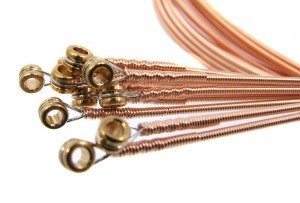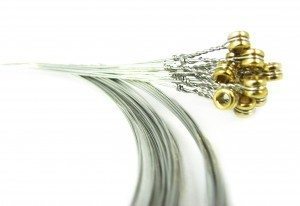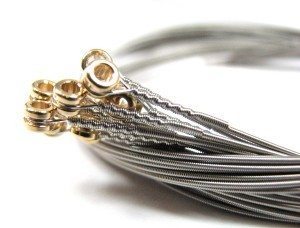After the GDG “Open G” tuning, the next most popular on 3-string cigar box guitars is probably DAD “Open D”. This tuning actually shows up, in part, on standard 6-string guitars, in the alternate “DADGAD” tuning. The lower-pitch versions of this tuning really have a low, bassy feel because of that big low D string, so it can be a very interesting option for cigar box guitar builders.
 This article follows the format used in our first article on cigar box guitar tunings, which covered the GDG Open G method. If you read that article, you may find some of this repetitive – feel free to skip down to the bottom where the specific string sizes are listed! – Gitty
This article follows the format used in our first article on cigar box guitar tunings, which covered the GDG Open G method. If you read that article, you may find some of this repetitive – feel free to skip down to the bottom where the specific string sizes are listed! – Gitty
I have actually personally tested and confirmed (and revised!) the string gauges listed below during the writing of this article, so this isn’t just theory and guessing!
These Open D string sets and Many More available over at www.CBGitty.com!
Before we dive in, a disclaimer: these recommendations are made based on our experimentation in the C. B. Gitty shops, and it is what we have found to work. Other people may have different opinions, and they are welcome to them. I’m not trying to set any standards or lay down any laws – I am just going to tell you what works for us.
The Four Possible DAD Tunings
Basically, on a 3-string cigar box guitar with a scale length in the range of 24 to 25 1/2 inches (scale length being the distance between the nut and the bridge), there are 4 different configurations of DAD that you can have, ranging from the lowest/bassiest to the highest/most trebly. Theoretically there are more potential combinations, but we’re just focusing on the cases where you have 3 strings of different sizes, strung from low to high pitch:
- Low-Low-Middle (Low D, Low A, Middle D)
- Low-Low-High (Low D, Low A, High D)
- Low-Middle-High (Low D, Middle A, High D)
- Middle-Middle-High (Middle D, Middle A, High D)
 Each one of these will have a different overall sound and feel. The first option uses all wound strings, and will have the strongest bass of the four. The other three varieties use a mix of wound strings and that nice high D string as well, and will have that higher-pitch influence which can be very nice.
Each one of these will have a different overall sound and feel. The first option uses all wound strings, and will have the strongest bass of the four. The other three varieties use a mix of wound strings and that nice high D string as well, and will have that higher-pitch influence which can be very nice.
Deciding which option is right for you is mostly a matter of preference, and experimentation. All four can be used to play tablature and lessons intended for guitars tuned to DAD. You have to decide whether you want the low growly bass of the low strings, the treble of the high strings, or a mix).
Just Looking for Gitty’s Recommendation? Here You Go
If I had to arbitrarily make a recommendation of which one you should use, I would probably go with #3: Low D, Middle A, High D. In my opinion, this mix of bass and treble gives the fullest sound and the most versatility. The fourth option (middle D middle A high D) is also very nice. As mentioned above, everyone’s tastes differ, so try them out and see what you like!
Now, on to Strings
Basically, there are 5 potential strings that are needed to achieve these 4 tunings. They are:
- Low D
- Low A
- Middle D
- Middle A
- High D
If you think of a standard 6-string guitar, or if you want to use a standard guitar string pack to do these tunings, you can think of it like this:
- Low D – take the low E string (the biggest wound string) and tune it down a full step to D.
- Low A – this is the same as the low A string on a standard guitar – the second biggest wound string.
- Middle D – this is the same as the middle D string on a standard guitar – the third biggest wound string.
- Middle A – the easiest way to get this is to tune the middle G string (the smallest of the wound strings) up a full step to A. You could also crank the unwound B string down a full step – having an unwound string as your Middle A presents some interesting possibilities (while our chart below doesn’t cover that, if you want to have a go at it I would recommend starting at a .018″ plain steel string and see what you get).
- High D – For this one you’d need to either take the high E string (the smallest unwound string) and tune it down a full step to D, or take a lighter-gauge B string (second biggest unwound string) and crank it up a step and a half to D.
String Weights and Gauges
If you want to know recommended string gauges for buying in bulk, then the chart below should help you pick out the specific gauges you’ll need. Remember that moving to a larger string gauge means you’ll have to crank it tighter to reach the same pitch, compared to a smaller gauge.
Also remember that the chart below is specifically for “standard” scale instruments, that fall an inch or so on either side of a 25″ scale length.
We give both “heavy”, “medium” and “light” recommendations below, so you can pick a set best suited to your instrument. Heavier strings will have to be cranked tighter than light string sets to reach the right pitch, and this will put more tension on your guitar, bowing your neck more, etc. I recommend starting with the lighter gauge strings and experimenting from there.
These sizes should work with both acoustic and electric guitar strings. Generally electric guitars are strung on the lighter gauge size. The gauges below are hyperlinked to the bulk strings listings at CBGitty.com, where available.
| Desired Note/Pitch | Light Gauge | Medium Gauge | Heavy Gauge |
| Low D | .052″ Wound | .054″ Wound | .056″+ Wound |
| Low A | .042″ Wound | .044″ Wound | .046″+ Wound |
| Middle D | .030″ Wound | .034″ Wound | .036″+ Wound |
| Middle A | .020″ Wound | .024″ Wound | .026″+ Wound |
| High D | .012″ Plain Steel | .013″Plain Steel | .014″+ Plain Steel |
Finally! Specific String Size Sets for Specific Tunings
So from all of this, we can get some recommended string sizes to achieve the 4 tunings mentioned above. For this example I’ll list the “Light Gauge” sizes, but you should be able to easily pick out the medium or heavy gauge sizes if you want. We have included an audio clip of what each string set sounds like to help you get an idea.
These exact Open D string sets and Many More available over at www.CBGitty.com!
- Low D – Low A – Middle D: .052″ Wound, .042″ Wound, .030″ Wound
- Low D – Low A – High D: .052″ Wound, .042″ Wound, .012″ Plain Steel
- Low D – Middle A – High D: .052″ Wound, .020″ Wound, .012″ Plain Steel
- Middle D – Middle A – High D: .030″ Wound, .020″ Wound, .012″ Plain Steel
The Wiggle Room Factor: you can generally get by with a little larger or little smaller string for any given pitch. Each string has its ideal tension zone, but the edges of that zone are a bit gray. If you keep breaking a string trying to hit
 a particular pitch, try a smaller gauge string! If a string seems too loose and flappy, move to a larger gauge string.
a particular pitch, try a smaller gauge string! If a string seems too loose and flappy, move to a larger gauge string.
So there you have it! Hopefully this will make this sometimes arcane-seeming subject a little easier to understand for folks.
Thanks for reading, I hope you found it useful!


How would you acheive these tunings on shorter scales, like ukelele scale lenghts??? Can you get a dulcimer type of tuning on short scale strummers? What strings would you use there? Thanks…
Wonderful info
Thanks a lot
Thank you, Jerry, for sharing your experience here and for your kind words.
These tunings a very interesting, I have maybe made 45-50 CBG.s and use GBD and DF#A tunings for open G and D, I seem to handle that better when using open G it is easier to get minor chords and phony 7 ths, just my experience, Thanks for all your help and info. Jerry
Thanks for the dedication Ben! Very helpful
Good stuff Ben, You guys are an endless stream of information and inspiration.
The sound clips is a GREAT addition! Smart!
Ben the series on Tuning/Strings is very helpful.
Thanks.
Simple but very helpful.
Thanks